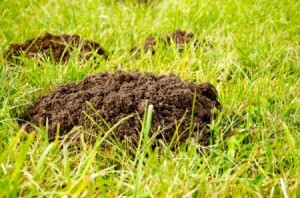
Hardiness Zone: 6a
Betty from Middletown, NY
The grubs most damaging tend to be the grubs from Japanese Beetles, June Beetles and European Chafer. Here are some environmentally friendly strategies for controlling them.
1. A healthy lawn is your best defense, so over-seed your lawn to keep it nice and thick. Also, the more healthy your lawn, the less damaged it will appear. Avoid grass mixes with weak roots like Kentucky Blue Grass.
2. Attract more grub-eating birds to your yard with water, nesting and feeders. Certain species of birds, like European starlings, blue-jays, purple martins, crows, grackles, meadowlarks, cardinals, blackbirds and robins all eat grubs. Starlings, robins and cardinals will also eat adult Japanese beetles. You can run a rake over infected areas to help turn up emerging grubs for visiting birds.
3. Raising the deck on your lawnmower will encourage more spiders and ants, both of which will help control the grub population.
4. Hand pick the adult Japanese beetles. To identify adult Japanese beetles, look for 3/8-inch long metallic green beetles with copper-brown wing covers. They can be distinguished from other similar looking beetles by the five small white tufts that project from under the wing covers on each side, and a sixth pair at the tip of the abdomen.
5. I've never tried this, but certain flowers that contain geraniol, like white geraniums, 4 o'clocks (mirabilis), larkspur, red and dwarf buckeye and castor bean plants are supposed to attract and poison adult Japanese beetles. If nothing else, they may attract the pests to one area where you can spray them with a soapy insecticide or remove them by hand.
6. Apply Parasitic Nematodes. Upon penetrating a grub, the nematode inoculates the grub with the bacteria. The bacteria reproduce quickly, feeding on the grub tissue. The nematode then feeds on this bacteria and progresses through its own life cycle, reproducing and ultimately killing the grub. Heterorhabditis bacteriophora is a type of commercially available nematode for grubs.
7. Milky Spore. This is a bacterium that once ingested by grubs, builds up in their blood, eventually causing their death. It's considered a long term solution and is usually used in areas experiencing severe infestations. Its needs to be applied over the course of a couple of seasons (2-4 years) in order for it to build up in the soil. After that, it is supposed to last for a decade or longer. Ask your local garden center or extension office where to get milky spore in your area.
Good luck!
Ellen
Here are the questions asked by community members. Read on to see the answers provided by the ThriftyFun community.
Can I use milky spore and nematodes during the same time period?
By John
According to this website it is a good idea. www.ecolandscaping.org/
I have well water. What is safe to use for getting rid of grub worms, that will not harm my well?
By Steve
I also have a well and grubs. My well is about 250 feet deep. I have used grub controll products. I put down 5 bags a few weeks ago and the grubs are still there.
How can I get rid of grubworms in my garden?
By Slingshot_317 from Fort Worth, TX